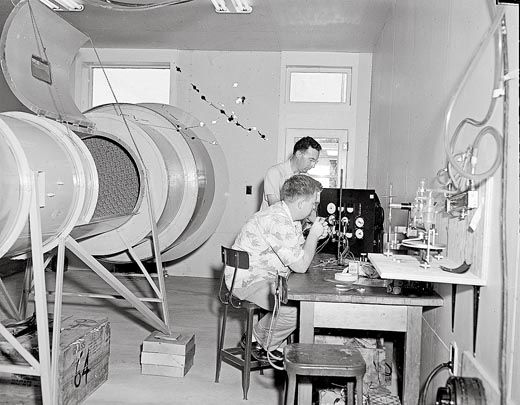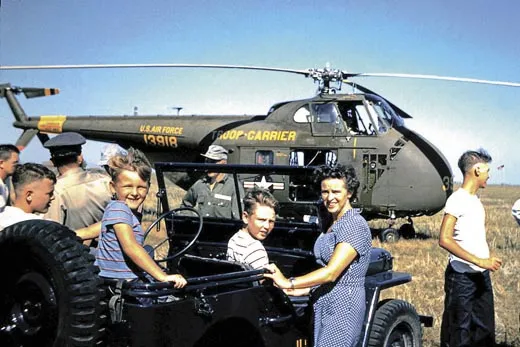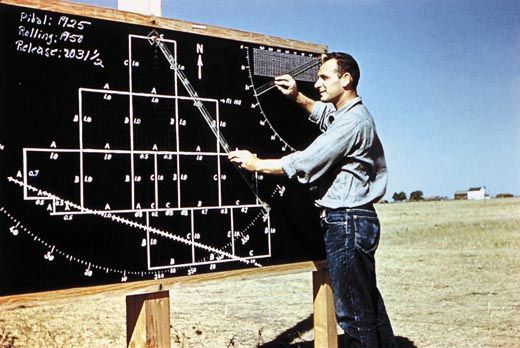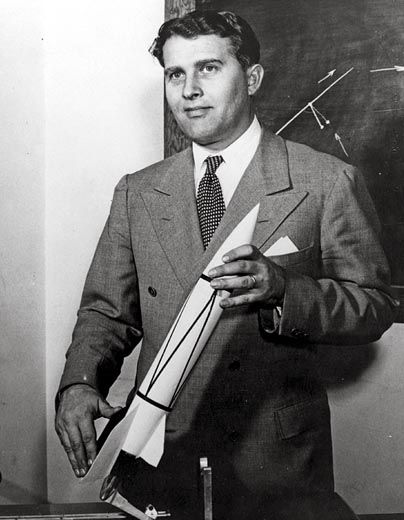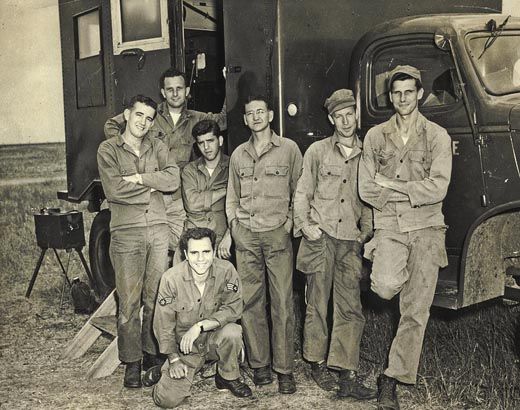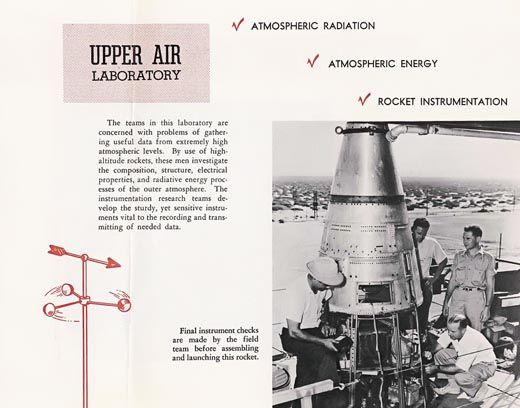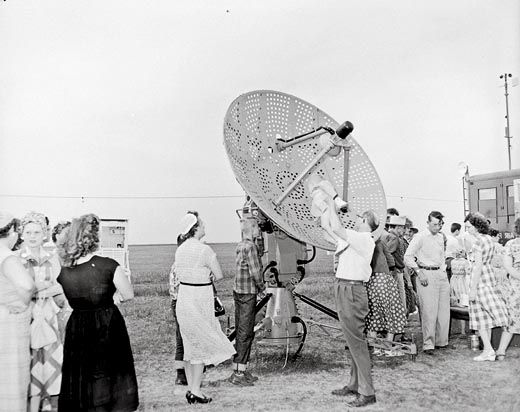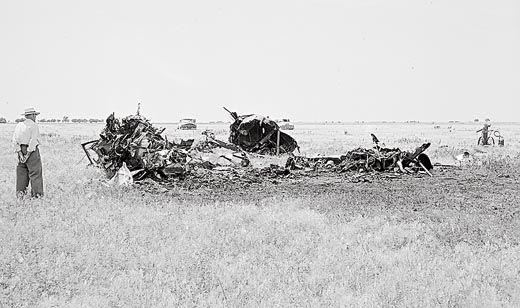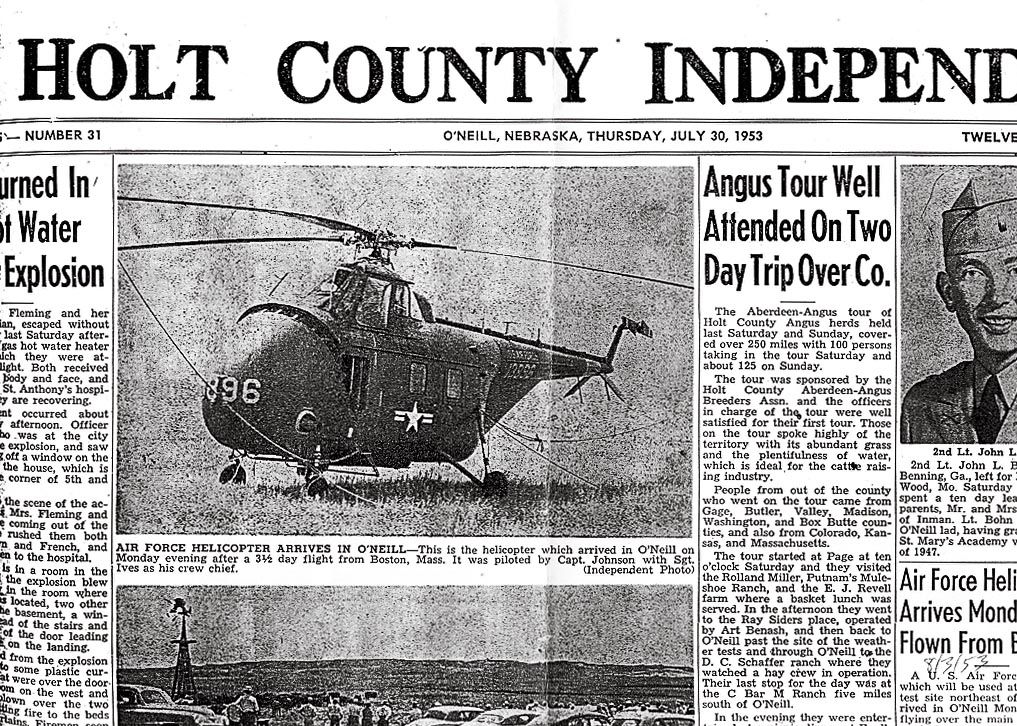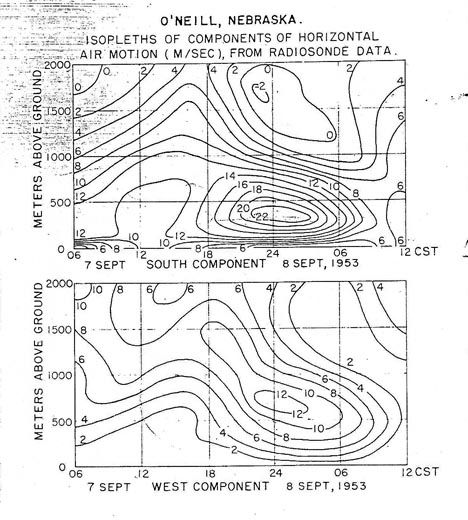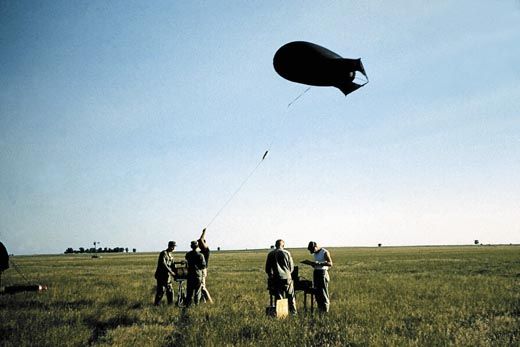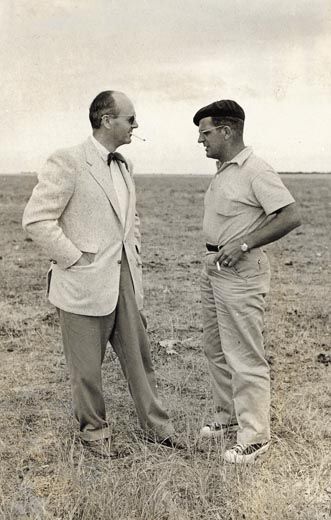Prairie Wind
In Nowheresville, Nebraska, the Air Force learned a thing or two about turbulence.
/https://tf-cmsv2-smithsonianmag-media.s3.amazonaws.com/filer/Arch_Prairie_Flash_ON09.jpg)
Jim Ryan was only 15 at the time, but he remembers his father’s negotiations in the spring of 1952 to rent the U.S. government some land six miles outside O’Neill, Nebraska. It wasn’t so much the military’s plan to conduct experiments there that stick in his mind; it was the tall German-born scientist heading the advance team, who took the time to shake the boy’s hand. Wernher von Braun was memorable, Ryan recalls, because everybody, from the two German scientists with him to the researchers who came later, seemed to defer to him. Von Braun commanded the attention of everyone in the room, including Ryan’s father Neil, who, as an influential businessman and prominent landowner, was an imposing figure himself.
The land deal was for an Air Force project to study the air, and not von Braun’s experiment. Jim found it odd, then, that what was about to happen in O’Neill was important enough to get the famous rocket scientist involved. “He wanted to stop in and see what the hell was going on,” says Ryan. The teenager was an airplane enthusiast, so he had read about von Braun (and the next year bought a Piper J-2 Cub for $300) and had an inkling of the importance of the tests, “because of what these guys talked about, coming in and out of my dad’s offices…. I remember von Braun’s whole manner. He was definitely in charge without yelling and screaming. He was very impressive, one of a kind. I knew I was shaking hands with somebody great.”
What Ryan didn’t know was that von Braun had been trying to conduct this very experiment since World War II. His V-2 rocket had failed as a weapon for the Nazis, and one reason, along with problems in the guidance system, was air movements near the ground that kept the flying bombs from hitting their targets. Scientists had no idea how the air behaved from the ground up to about 5,000 feet. Almost 10 years later, they were no closer to answers.
Accompanying von Braun in the land negotiations were two former countrymen: meteorologist Heinz Lettau, in charge of the Air Force project, and ballistics expert Guenter Loeser, who, like von Braun, had been brought to the United States after World War II as part of Operation Paperclip to augment U.S. research. Lettau and Loeser now worked for a new division of the Air Force called the Geophysics Research Directorate, based in Cambridge, Massachusetts, while von Braun worked for the Army. Lettau and Loeser were looking at the O’Neill test to further the science of rocketry, but the resulting data would end up proving helpful to aviation, agriculture, and even weather forecasting.
Von Braun’s priority at the time was to put a man in space; the directorate’s was far different. The Air Force faced a serious problem: Planners wanted to add guided missiles to the service’s fleet of fighters and bombers, but scientists had no idea how low-level atmospheric conditions might affect the missiles’ trajectories or even whether the missiles could hit their targets. Changes in wind and air pressure in the first mile of atmosphere could also have a detrimental effect on the performance of new jets the Air Force was testing. To understand how air near the ground behaved—how it circulated, how it warmed and cooled—the Air Force was taking temperature and barometric readings every few hours at base runways. Lettau was called in to figure things out. If successful, his experiment would give the Air Force standards it could follow without continually having to take runway readings.
A quiet, conservative man who always dressed in a sport coat and bow tie, Lettau had been trying to map air movements since the 1930s, when he was with the German Weather Bureau. Now working for the geophysics directorate, he received data from more than a dozen universities across the country. But hundreds, sometimes thousands of miles separated the schools, with different types of land and air at each. He finally convinced the Air Force that the only way to accurately study and predict air movements was to bring all the university minds to one place and use the outdoors as a giant laboratory. He needed somewhere flat, with a near-constant breeze, and a community nearby to help support and house the scientists.
“The time was just right for this,” Lettau told me, not long before his death in 2005. “Such new possibilities for warfare had opened up. Most of these new types of warfare were relying in some way on atmospheric effects. Basically, they had always to rely on the same meteorological elements: that’s the wind distribution at the ground. So my argument with the Air Force was that in order to really get the full benefit of all of this [university] contract work, [you have to] bring all these people together with the equipment to see how the basic terms...agree with each other.”
In Lettau’s mind, the Air Force needed two things: first, to be able to accurately guide a missile to its target, and second, to understand how radiation from a nuclear strike would move in low-level winds.
After scouring daily reports from the National Weather Service’s field offices, Lettau settled on the little town of O’Neill, where the prairie wind blew southward at a near-constant rate.
Before the experiment began, say longtime residents, Neil Ryan’s site was dotted with cornfields and cows; when I visited 55 years later, it looked much the same. Gravel roads are still the only route to the field. The base camp and major experiments took up about 11,000 square feet of land, while the monitoring and testing stretched for a 1.5-mile radius. Ryan also owned an office building in town, and the scientists used that for workspace and to house a small wind tunnel for calibrating equipment.
O’Neill had a population of only about 4,000, with an economy based on farming. But the town served as a transportation hub for northeastern Nebraska, with a railroad depot and two highways, 20 and 281, that converged in the middle of town, at the main street’s only stoplight. That made it convenient to ship in tons of equipment. O’Neill also had one large hotel, the Golden, in its center, and a couple of smaller motels. The directorate had already anticipated taking every vacant room, but an invasion of Air Force personnel would need a lot of support and help from the residents. Knowing the team would have to win over the town, Guenter Loeser returned to O’Neill early in 1953.
Like von Braun, Loeser had a way with people, and he spent a couple weeks talking to O’Neill’s leaders and businessmen to enlist their help. He visited the town’s two newspapers, the Frontier and the Holt County Independent, to get the word out about the project and recruit workers. Residents took a liking to him immediately. The flamboyant German scientist seemed the polar opposite of the reserved Lettau. Loeser, who liked to wear a beret, was outgoing and talkative, and willing to place bets with anyone that the United States would put a man on the moon in the next 20 years.
To inform the town of the directorate’s intentions, Loeser wrote a press release that ran in both newspapers, explaining that the wind experiment “will be necessary for the use of guided missiles.”
Starting in late spring, members of the Air Force and their university partners began streaming into town. Many, including Lettau, brought their families. “The O’Neill Chamber of Commerce is badly in need of more housing for the Air Force men and scientists,” the Independent reported on July 9. “It is imperative that more rooms be made available to these men. The number now has been set at 180 men.” O’Neill’s residents rushed to help. Spare bedrooms were opened up. Garages became apartments.
“The biggest thing was: Where do you put them up?” says Jim Ryan, now retired in McDonough, Georgia. “These people were from Boston and New York, all over the country. They were really taken aback by how friendly everybody was. If they’d needed your car, we probably would have let them use it. It really kind of blew them away. They were fantastic people. We really enjoyed them and they really enjoyed us. It was like going to the zoo, I guess. Them and us looking at each other. What was interesting to me wasn’t the wind tracking, but the people. They added another dimension to the whole zoo.”
Soon after the visitors were settled, the equipment began to arrive. One shipment, from Offutt Air Force Base in Nebraska, contained nearly five tons of gear. Fifteen institutions were committed to the tests, including Argonne National Laboratory, the Air Force Cambridge Research Institute, and universities from Maryland to California. Each brought its own equipment. Iowa State College even hauled in a computer to help process the data; it filled an entire room.
By most accounts, the scientists loved the location. Ryan’s prairie field gave them the perfect test site, and the town supported their efforts. Air Force officers felt differently. Some were on the field all day long, and the landscape wore on them. Without trees or other obstacles on the site, wind raked through so strongly that even the grass bent sideways. They began calling it, derisively, the “flattest piece of land in the free world.” Project engineers erected 50-foot-tall towers around the field to hold sensors and anemometers, instruments that gauged the strength of the wind by catching it in what looked like ping-pong balls cut in half and fixed to small, horizontal windmills.
Those in the rank and file were happy in O’Neill. Former airman Wally Wimmer, for one, was thrilled with the assignment—and ended up returning to the town half a century later to retire. Wimmer was part of an Air Force communications wing sent in to keep channels open between O’Neill and the directorate headquarters in Massachusetts. “They gave us a per diem to go off base,” he told me as we gazed at the field. With the extra money, the Air Force men spent freely at night in the town’s bars and American Legion hall. Wimmer and his crew lived in nearby homes, so they had no housing costs, and meals were usually thrown in. The men might eat in town, only to come home and find a full dinner waiting for them. “We also got activation pay for being taken away from our homes,” he says, making duty in O’Neill financially rewarding.
By mid-July, the test site had become a self-contained community, with sleeping quarters, a fire department, and medical facilities. It had fresh water as part of the lease with the Ryan family, whose ranch was on adjacent land. The site even had its own electrical grid, which, when powered up for the first time, caused some confusion in town. “There are 115 lights in a string which is about seven-tenths of a mile in length,” the Independent reported. “Seen from a distance, the lights looked a great deal like a prairie fire.” The military gave the experiment an official title—The Great Plains Turbulence Field Project—and a budget of $1 million (the equivalent of about $7 million today). “They really didn’t explain to us what it would accomplish or what the purpose was,” Wimmer says. “All we knew was that it was a wind turbulence program of study from zero to 5,000 feet.”
Later that month, the Air Force flew in a Sikorsky H-19 Chickasaw helicopter from Massachusetts that would be critical to a testing technique Loeser had developed. The chopper was to hover at 5,000 feet and drop a rack filled with small explosives that would go off at various times, making puffs of smoke in a vertical line on the way down. A camera on the ground would photograph what effect, if any, the wind had on the smoke. Loeser was anxious to begin his experiment, but he had hit a snag. The pilot had inspected the helicopter upon arrival and found a problem with one of its blades. Undaunted, Loeser asked the Air Force personnel to try a test run. He wouldn’t go at full altitude or speed, but he wanted to make sure that the crew got trained for the mission. It was a terrible mistake.
The helicopter wasn’t in the air long when Wimmer saw it was having trouble. As the H-19 circled, he saw a blade come off, sail backward, and smash into the tail rotor, causing the chopper to crash. Wimmer and a fellow airman grabbed a jeep and barreled through a barbed wire fence to get to the wreckage. They pulled out the pilot and copilot; both were dead. As Wimmer reached the back of the chopper, the explosives in the rack started to detonate. With shrapnel flying everywhere, all he could do was flee and watch the chopper burn with the 39-year-old Loeser and three airmen inside.
The team was devastated. The man who had done so much to set the stage for the experiment was dead. He would never see the results of his technique, nor collect on all the moon bets he’d made (Loeser had been right: Apollo 11 landed on the moon 16 years later).
The crash was still under investigation when the Air Force brought in a new helicopter and personnel. Testing started as scheduled on August 1. And once it began, it was constant. For evening tests, the directorate hired 12 local high school students to launch balloons. Jim Ryan was one of them. The first week the students counted how many steps they took in a mile; the count was necessary to space the balloon releases accurately. Each evening, the students took weather balloons with high-intensity light bulbs attached and walked until they were spaced about a quarter-mile apart over a three-mile stretch. Then they released the balloons at various intervals, and cameras photographed the lights in the sky. The paths of the balloons showed movements of the air. “In early afternoon, the Air Force bus would come into O’Neill and pick us up,” Ryan recalls. “I worked the tests every night for a month.”
Lyle Fox, who worked with Ryan launching the balloons, remembers the goal was to try to get two experiments in every night. Fox, who still lives in O’Neill, recalls the difficulty of walking through the thick prairie grass at night, blinded by the bright light attached to the balloon. “You might run into a cow, or scare up a pheasant,” he says. “They won’t fly away until you’re almost on top of them, and it’s enough to make your heart stop.”
More than once, Ryan recalls, the pheasants caused a delay in the tests. “Once in a while a boy would get the daylights scared out of him and let go of the balloon,” he says. “You’d hear the scientists yelling to stop the balloon launch or shouting at the kids because launching it early would stop the whole test.”
On the communications side, “it got to be hairy sometimes because you had to have a 24-hour-a-day communications guarantee,” says Wimmer, “because they worked all the different hours, because weather conditions would change, and they wanted everything on the test they could have, and every weather condition they could encounter.”
The testing ended after five weeks, on September 8. While it had taken months to negotiate, prepare, and build up the site, tearing it down was quick work.
The Air Force took nearly four years to analyze the reams of data collected in O’Neill, compile them, and publish the results. The two-volume report was entitled Exploring the Atmosphere’s First Mile, and was classified until 1969. The first volume is dedicated to Loeser and the airmen killed in the helicopter crash.
It turned out that the airborne test Loeser developed gave the scientists their most significant discovery. The puffs of smoke had revealed a sharply defined layer of wind, with a maximum speed of 55 mph, at about 1,200 feet (at ground level the air moves only modestly, and from 4,000 feet and up it is fully calm). In essence, the scientists had discovered the existence of a low-level jet stream that Lettau described as being like a sheet or a wall that was far different from the fluid movements of the jet stream in Earth’s upper atmosphere. “This, of course, was one of the major successes,” Lettau told me. “What we found about the low-level jet stream in the O’Neill experiment is unsurpassed because of the Loeser technique.” Scientists now had a method by which they could measure and analyze air movement near missile test sites, he said.
The results from O’Neill were the benchmark for low-altitude atmospheric science for 15 years, until they were eclipsed by measurements over tests done in prairie grasslands in Kansas (1968) and northwestern Minnesota (1973).
“This was, up to its time, the most complete set of experiments done on that part of the atmosphere,” says Don Lenschow, a senior scientist at the National Center for Atmospheric Reseach in Boulder, Colorado. “The value of O’Neill was that it showed you had to bring together a lot of different techniques, and you had to get auxiliary measurements in order to get the complete picture. It also allowed
intercomparison of techniques measuring the same thing. People didn’t know if they could trust a particular tool until it was compared with other instruments.”
The findings had profound effects in fields beyond rocketry. University scientists used their data on wind currents to help farmers determine when to plant seeds for best yield, how fast surface moisture would evaporate, and how to use pesticides to maximum effect. Until the experiment, it was nearly impossible to improve farming techniques because farmers could never predict the winds; now scientists had a way to study the effect of air movement on crops, topsoil, and pesticides. They found, for example, that variations in soil temperature had an effect on the air movement above. And the moving air allowed agricultural pests to migrate for miles, a phenomenon that was not well understood until the tests.
The research helped improve weather forecasting techniques that the Air Force needed to become capable of flying in all kinds of weather. It also provided some surprises, including the finding that air above seemingly hot runways was actually cooler than air over grasslands. “They didn’t want to believe it, but [the Air Force] gave up asking that all measurements of air density should be made about the runway,” Lettau said.
As for Wernher Von Braun, who had long touted the virtues of such tests, he launched his first Redstone missile for the Army in 1953, four years before the O’Neill results were published. “It’s one part of a bigger picture of understanding the atmosphere,” says Michael Neufeld, a curator of space history at the National Air and Space Museum and the author of Von Braun: Dreamer of Space, Engineer of War. “It’s useful, but so is a lot of other data you need if you’re going to have a ballistic missile program. You need data on forces and weather, wind conditions and guidance control, for the whole column of air up to space.”
Ryan’s family sold the old field more than a decade ago. Today, there’s little evidence that half a century ago it bustled with activity, with towers and anemo-meters and scientists living and working. No historic plaque marks the site; there is only irrigation equipment and grazing cattle. The one constant is the steady southerly breeze that still bends the prairie grass in the free world’s flattest land.
Dave Manoucheri, who grew up in O’Neill, Nebraska, after the atmospheric studies, manages a freelance television investigative unit in El Dorado Hills, California.
